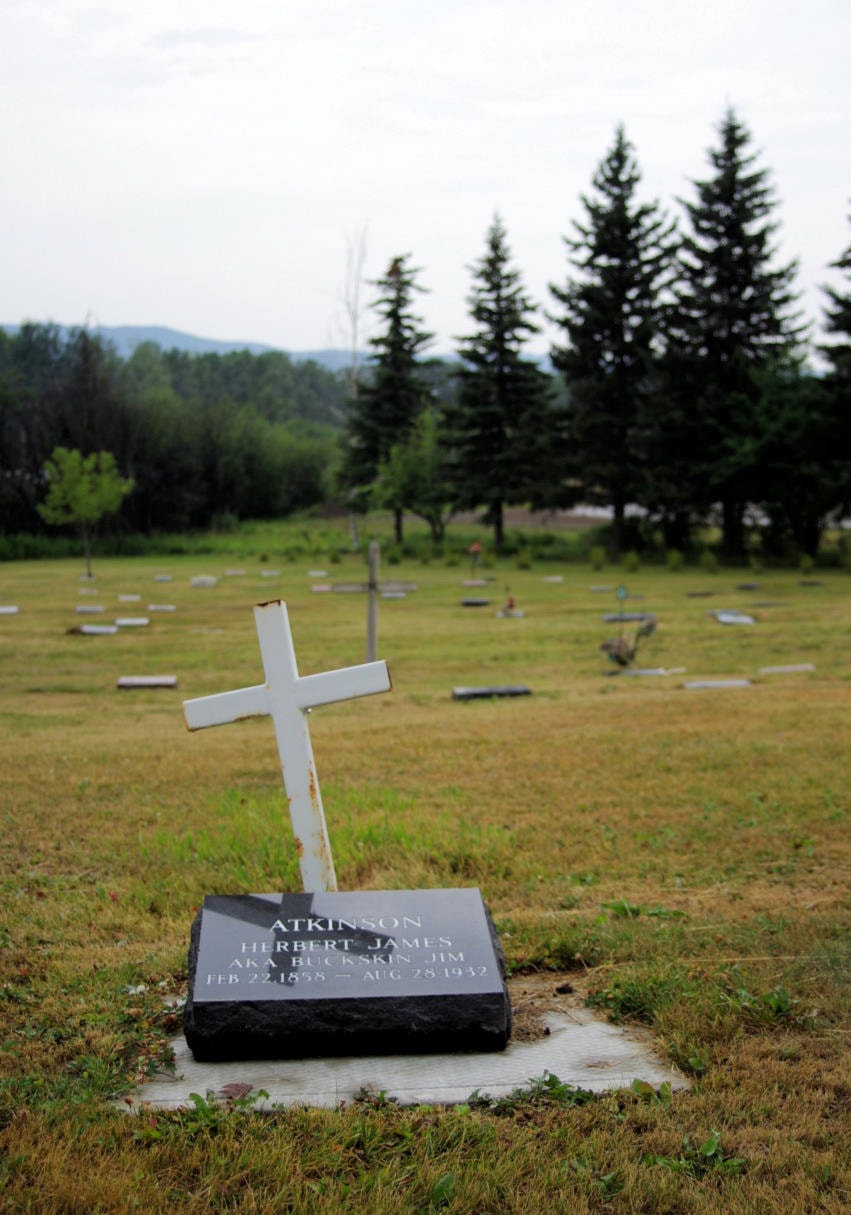Herbert (James) Atkinson died in the Burns Lake Hospital on Aug. 28, 1932 and was buried in the Burns Lake Cemetery. The following is his obituary, which ran in the Sept. 1, 1932 edition of The Observer: Survivor of Custer Massacre dies in Burns Lake Hospital. H. (James) Atkinson served as scout under Col. Custer and Col. Reno and was friend of Buffalo Bill and other pioneers.
“Concluding seventy-six years of active life, most of which had been spent on the frontier and in pioneer districts, H. Atkinson (known to most of his friends as James Atkinson) of Francois Lake breathed his last in the Burns Lake Hospital on Aug. 28. He had been in a very critical state of health for two months and his illness extended over a period of two years.
“Mr. Atkinson was born in the State of Michigan, and he has been a pioneer all his life. He had many a fight with the Indians in the central States during his early youth and manhood and he was for many years a scout with Marcus A. Reno, later promoted to Colonel, U.S.A. and Brigadier General, U.S.V. Mr. Atkinson was at Colonel G.A. Custer’s last stand when he fought Sitting Bull’s band of Sioux, some 9,000 strong, at the Little Big Horn, Montana, when the colonel was slain and his force of 1,100 practically wiped out. In 1883 when “Colonel” W.F. Cody (better known as Buffalo Bill) was making the preliminary organization for his well-known wild west show, he offered Mr. Atkinson a half interest in the undertaking. They had been scouts together for many years, but the partnership in this venture was not consummated.
“As a souvenir of his years of scouting and fighting, Mr. Atkinson carried the marks of several arrow wounds and nine bullet wounds in his body.
“In 1898, Mr. Atkinson married Pauline Lefort, who was living east of Winnipeg, and shortly afterward they made their residence in Montana. In 1904 the family emigrated to Saskatchewan and homesteaded 14 miles west of Swift Current and in 1918 they came to Francois Lake where they have since resided.
“Immediately surviving relatives are Mr. Atkinson’s widow, three sons, James of Brewster, Wash., Elmer of Munson, Alberta, and Dewey of B.C., three daughters, Mrs. Elizabeth Tibbits of Grand Forks, B.C., Mrs. A. W. Douglas, Tacoma, Wash., and Mrs. J.L. Frank of Terrace, B.C., also nine grandchildren.
“The funeral services were conducted in St. John’s Church (Anglican), Burns Lake, and at the Burns Lake Cemetery by Rev. C.A. Hinchcliffe. A large number of friends and mourners were present and many floral remembrances cover the bier.
“The deceased was widely known and greatly respected, in the Lakes District and other points where he had previously resided.”
So was James Atkinson a survivor of Custer’s Last Stand?
It’s difficult to say. While it is generally accepted that all of the 200-plus men directly under Lt. Col. George Armstrong Custer’s command on June 25, 1876 died, hundreds of men serving with Custer’s subordinates at Little Bighorn survived. The last confirmed survivor of Little Bighorn – Charles Windolph – died in 1950 at the age of 98. Windolph was a soldier in H Company under the command of Capt. Frederick Benteen, and received the Congressional Medal of Honor for his actions at Little Bighorn.
Between 1876 and 1930, at least 70 men claimed to be survivors of one of the five companies that made that final stand atop Battle Ridge. Most of their stories proved to be works of fiction, but at least one has become the stuff of legend.
Frank Finkel of Dayton, Washington claimed he survived the battle. Finkel, who died Aug. 28, 1930 at the age of 76, said his horse bolted and carried him away from the fight.
Although some aspects of Finkel’s story are suspect, the comments of at least one combatant lend some credence to it. In 1894, Rain-in-the-Face – a Lakota war chief who participated in the Battle of Little Bighorn – told W. Kent Thomas that “one long sword escaped. His pony ran off with him and went past our lodges (at the foot of Calhoun Hill).”
Historians are divided on the veracity of Finkel’s claim. Some note that several of the details in his account could only be known by an individual present at Little Bighorn on the ill-fated day in 1876. Others point to the fact that there is no record of Frank Finkel having served in Custer’s Seventh Cavalry.
The Friends of the Little Bighorn Battlefield has compiled what many consider the most comprehensive list of soldiers, officers, and civilians who were present at the Battle of the Little Bighorn. Finkel’s name is not among those listed.
Neither is Atkinson’s – but that doesn’t conclusively prove he wasn’t there. Many men enlisted under false names. Even the Friends of the Little Bighorn Battlefield admit that their list is only “as good as it can get – for today.”
Much of what happened more than 140 years ago on that wind-swept ridge above Montana’s Little Bighorn River remains a mystery. James Atkinson, formerly of Burns Lake, is part of that mystery.
© 2018 Michael Riis-Christianson and the Lakes District Museum Society
